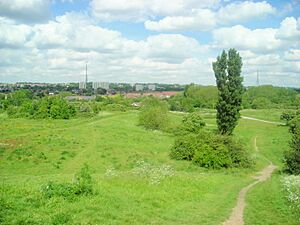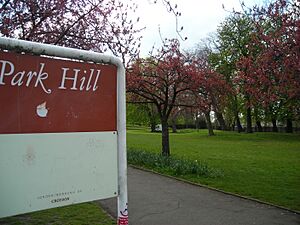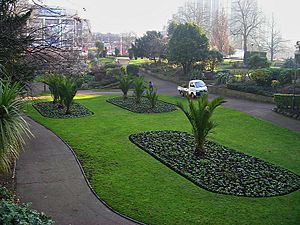Parks and open spaces in the London Borough of Croydon facts for kids


The London Borough of Croydon is a really green place! It has over 120 parks and open spaces within its borders. These range from huge nature spots like the 200-acre (80-hectare) Selsdon Wood Nature Reserve to many smaller sports fields and playgrounds. Croydon is quite a large area, covering about 86.52 square kilometers. It has lots of hills and rivers that stretch across the borough and into the North Downs and Surrey. Some of Croydon's open spaces are even part of the famous London LOOP walking trails. The very first part of this trail opened on May 3, 1996, at Farthing Downs in Coulsdon. Since Croydon is in Outer London, it also has some lovely countryside areas, like its country parks.
Duppas Hill was Croydon's first public park, bought way back in 1865. Addington Hills is a big area that helps manage water in London, especially for the Thames Valley. It was once a challenge for London to grow past this area. Mitcham Common is also partly in Croydon, though most of it is in the London Borough of Merton.
Parks like the Queen's Gardens, Park Hill, and Norwood Grove are great examples of beautiful gardens in the borough. There are also many recreation grounds, like the one in South Norwood, which is getting a big makeover. You can also find lovely meadows like Heavers Meadow and Brickfields Meadow, both in South Norwood.
Contents
A Look Back: History of Croydon's Woods
The Great North Wood was a huge natural oak forest that once covered the Sydenham Ridge and the areas around the River Effra. This forest is a big part of Croydon's history. A very important tree, called Vicar's Oak, marked the boundary of four old parishes: Lambeth, Camberwell, Croydon, and Bromley. People were talking about this "ancient remarkable tree" as early as 1718, and it's believed to have survived until 1825.
The earliest record of this wood is from 1272. It was owned by the Whitehorse family during the time of King Edward III. When Oliver Cromwell took control of it from the Archbishop of Canterbury, it was measured to be about 830 acres (3.4 square kilometers). At that time, it was known to stretch all the way from Croydon to Streatham. A lot of wood from this forest was used to build ships at the Royal Dockyard in Deptford, and also for making charcoal and other buildings. Much of the remaining forest was cut down and developed after 1797 and 1806. However, some important parts still exist today, like the nature reserves at Dulwich Wood and Sydenham Hill Wood.
Discover Croydon's Main Green Spaces
Besides smaller green areas like sports fields and gardens, and Selsdon Wood (which is owned by the National Trust), here are the main open spaces in Croydon:
Green Spots in North Croydon
- Norwood Grove, Upper Norwood: This park has a big mansion, beautiful gardens, and open parkland, covering 34.5 acres (14 hectares).
- South Norwood Country Park, South Norwood: This used to be a sewage farm but is now a large park, 125 acres (50 hectares) big.
- South Norwood Lake and Grounds, South Norwood: A big lake and green space area, covering 28 acres (11 hectares).
Parks in Central Croydon
- Lloyd Park, Croydon: This park was started by Frank Lloyd and is 114 acres (46 hectares).
- Addington Hills, Addington: Also known as Shirley Hills, a lovely hilly area.
- Queen's Gardens, Central Croydon: An urban park right next to the Croydon Clocktower.
- Park Hill Recreation Ground: An urban park next to the railway, with a tall water tower, covering 15 acres (6.1 hectares).
- Duppas Hill, Waddon: One of Croydon's oldest public recreation grounds.
- Addington Vale, Addington: This used to be green belt land and became a public open space in 1963, covering 48 acres (19 hectares).
- Mitcham Common, Merton: A very large area of common land, 460 acres (182 hectares).
- Purley Way Playing Fields, Waddon: A big green space next to the Croydon Colonnades, 109 acres (43.81 hectares).
Open Areas in South Croydon
- Happy Valley Park, Old Coulsdon: A countryside area, 252 acres (101 hectares).
- Farthing Downs, Coulsdon: Another countryside area in the borough, famous for its walking trails.
- Foxley Wood, Purley: An old urban woodland that is now a Nature Reserve. It's known for its many different plants and animals, and it has a nature trail. The Friends of Foxley group helps manage this woodland with the London Borough of Croydon.
Rivers and Waterways
The River Wandle is an important river that flows into the River Thames. It stretches for 9 miles (14 kilometers) from its main source in Waddon all the way to Wandsworth and Putney. For some of its length, it forms the border between the London Boroughs of Croydon and Lambeth. The main river starts in Waddon, and one of its smaller branches ends in Selhurst. Another branch starts in Thornton Heath as the Norbury Brook, then becomes the River Graveney, and joins the Wandle near Summerstown.
Wandle Park is one of 11 parks in Greater London that received money for improvements after a public vote. The park got £400,000 to make its footpaths better, add more lighting, fix up the public toilets, and create new play areas for kids.
How Green Spaces Affect Croydon's Climate
The amount of green space in an area can actually affect its local climate! Croydon has a temperate climate, which is common for most of Great Britain. This means it has mild temperatures. Its average yearly temperature is about 9.6°C. Croydon also gets less rain than the average for England.


